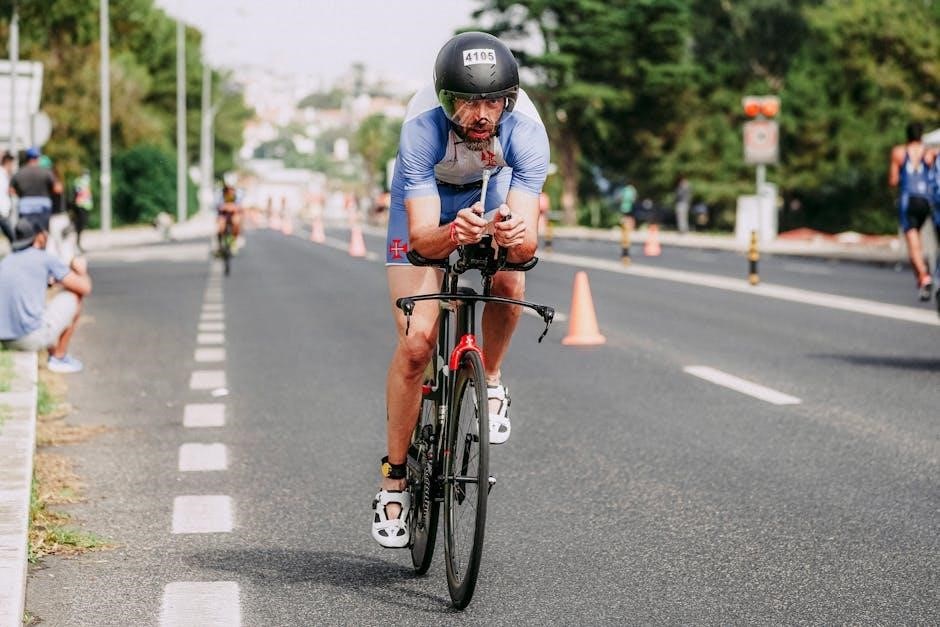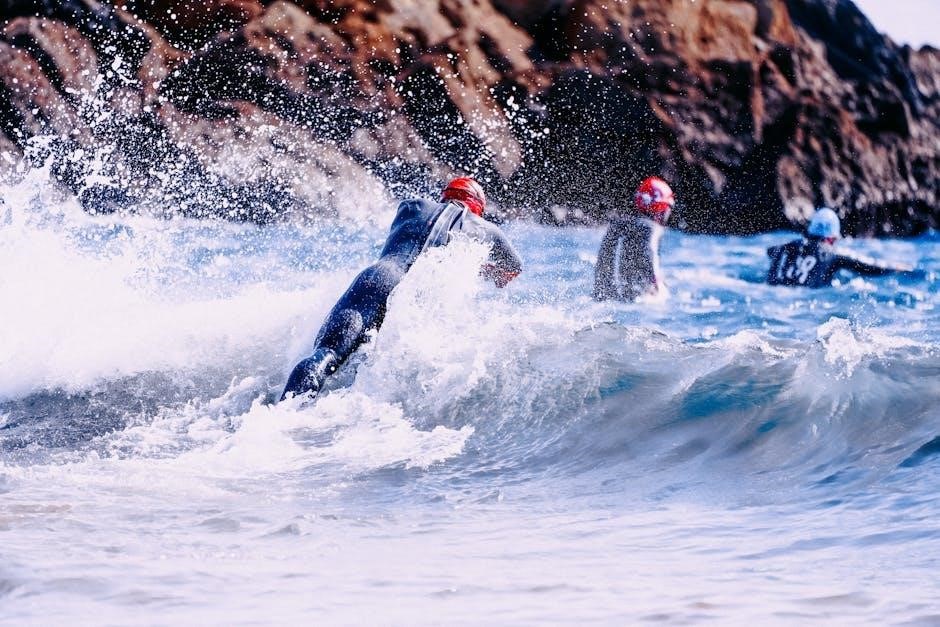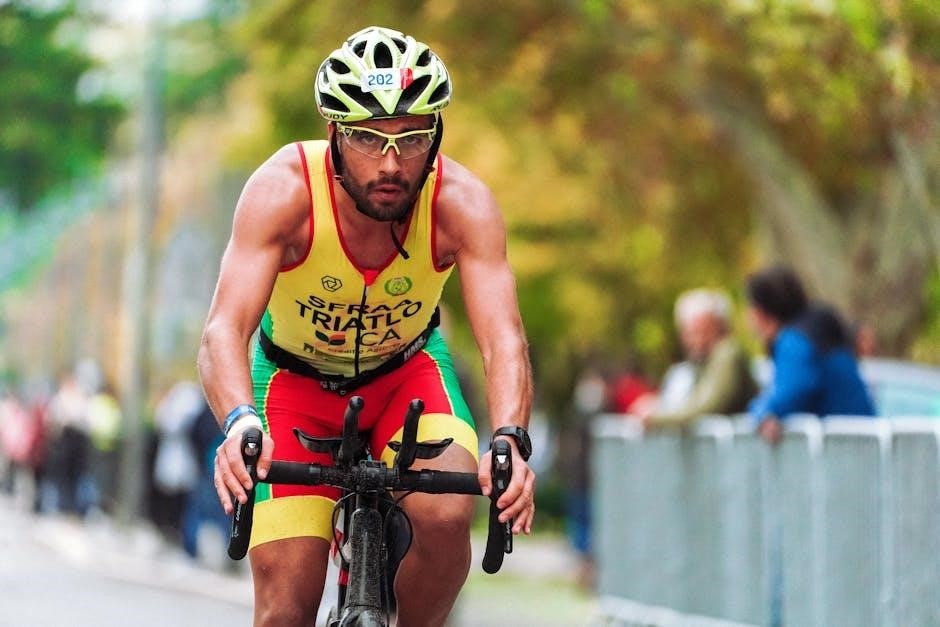ironman triathlon training plan pdf

Ironman triathlon training is a challenging yet rewarding journey requiring a structured plan. A well-designed training plan ensures progressive fitness, covering swim, bike, and run workouts, nutrition, and recovery strategies.
What is an Ironman Triathlon?
An Ironman Triathlon is a long-distance race consisting of a 2.4-mile swim, 112-mile bike ride, and 26.2-mile run, completed consecutively. It demands peak physical fitness, mental toughness, and endurance. Athletes must finish within 17 hours, making it one of the most challenging single-day events in sports. The race tests triathletes’ ability to transition seamlessly between swimming, cycling, and running while managing nutrition, hydration, and fatigue. Completing an Ironman is a testament to dedication, resilience, and rigorous training, earning participants the prestigious title of Ironman finisher.
Why a Training Plan is Essential
A well-structured training plan is crucial for Ironman success, ensuring progressive overload, consistency, and accountability. It helps build endurance, strength, and speed systematically, preventing overtraining and injuries. A plan also allows for periodization, breaking training into phases like base building, endurance, and intensity. This structure ensures peak performance on race day. Additionally, it guides nutrition, hydration, and recovery strategies, while tracking progress to make data-driven adjustments. A tailored plan keeps athletes focused, motivated, and prepared, making it indispensable for achieving Ironman goals.
Key Components of an Ironman Training Plan
An effective Ironman training plan includes structured workouts, periodization, and recovery. It combines swim, bike, and run sessions with strength training and mobility exercises. The plan should incorporate nutrition and hydration strategies, as well as mental preparation techniques. Rest and recovery phases are critical to avoid overtraining. Progress tracking through metrics like heart rate, pace, and power ensures accountability. A well-rounded plan balances intensity and endurance, preparing athletes for the physical and mental demands of the race.

Understanding the Basics of an Ironman Triathlon
An Ironman triathlon consists of swimming, cycling, and running, with distances of 2.4 miles, 112 miles, and 26.2 miles, respectively. It demands a well-structured training plan to build endurance, strength, and mental resilience. Proper nutrition, hydration, and recovery are essential for optimal performance. The race requires seamless transitions between disciplines, and mental toughness to overcome challenges. Understanding these elements is crucial for athletes aiming to complete this demanding event successfully.
Ironman Triathlon Distances
An Ironman triathlon consists of a 2.4-mile swim, 112-mile bike ride, and 26.2-mile run, totaling 140.6 miles. The swim is typically in open water, requiring endurance and technique. The bike segment demands sustained effort over long distances, while the run is a full marathon, testing mental and physical limits. These standardized distances ensure consistency across races, making it a true test of athleticism and dedication. Understanding these distances is critical for building a structured training plan tailored to each discipline.
The Three Disciplines: Swim, Bike, and Run
The Ironman triathlon comprises three demanding disciplines: swimming, cycling, and running. Each requires distinct skills and physical adaptations. Swimming demands endurance and technique in open water, while cycling tests strength and pacing over long distances. Running, the final discipline, pushes mental and physical limits after fatigue from the first two. Training for these disciplines involves building specific muscle groups, improving cardiovascular fitness, and mastering transitions between activities. Balancing these elements is crucial for a cohesive and effective training plan.
Transition Periods Explained
Transition periods in an Ironman triathlon are the intervals between the swim-to-bike (T1) and bike-to-run (T2) segments. These phases are critical for maintaining momentum and minimizing time loss. During T1, athletes quickly change from wetsuits to cycling gear, while T2 involves switching to running attire. Efficient transitions require practice, including fast clothing changes, proper bike handling, and quick shoe swaps. Mastering these skills can save valuable minutes, ensuring a smoother and more competitive race performance. Incorporating transition drills into training is essential for success.

Setting Realistic Goals for Your Ironman Training
Set achievable goals aligned with your fitness level, progressively increasing intensity. Stay consistent, track progress, and maintain motivation to build endurance and mental resilience over time.
Assessing Your Current Fitness Level
Evaluate your current swim, bike, and run abilities to determine your starting point. Consider your weekly workout frequency, endurance, and strength levels. Conduct benchmark tests for each discipline, such as a 1-mile swim time, bike power output, or a 10K run pace. Assess your overall consistency and recovery capacity. This baseline assessment helps identify strengths and weaknesses, ensuring your training plan is tailored to your needs. A realistic starting point is crucial for progressive overload and injury prevention.
Use heart rate zones, pace thresholds, or perceived exertion to gauge fitness. Track historical data from past races or workouts. Be honest about your capabilities to set achievable milestones. This evaluation phase ensures your Ironman training plan is both challenging and sustainable, setting the foundation for long-term success.
Setting SMART Goals for Your Training
Set Specific, Measurable, Achievable, Relevant, and Time-bound (SMART) goals to guide your Ironman training. Define clear objectives, like completing a certain distance or improving pace. Ensure goals are measurable, such as reducing swim time by 10% or increasing weekly bike mileage. Make sure goals are realistic based on your fitness level and schedule. Align them with your broader vision, like finishing the Ironman. Assign deadlines to track progress, such as hitting key milestones by specific weeks in your plan. This structured approach ensures focus and motivation throughout your journey.
Regularly review and adjust your SMART goals to stay on track. Celebrate achievements and address setbacks promptly. This goal-setting framework helps maintain direction and accountability, keeping you committed to your Ironman aspirations.
Creating a Balanced Training Schedule
A balanced training schedule ensures equal focus on swimming, cycling, and running, with adequate rest and recovery. Allocate time proportionally, with more emphasis on the bike due to its longer race distance. Incorporate rest days to avoid burnout and prevent injuries. Include strength training and flexibility exercises to enhance overall performance. Plan nutrition and hydration strategies alongside workouts for optimal energy levels. Balance intensity with endurance sessions, gradually increasing volume and difficulty. This holistic approach ensures comprehensive preparation while maintaining physical and mental well-being throughout the training period.
Consistency and progressive overload are key to building fitness safely and effectively. Adjust the schedule as needed to accommodate life commitments and recovery needs, ensuring long-term sustainability. A well-structured plan fosters confidence and readiness for race day.

Choosing the Right Training Plan
Selecting a training plan tailored to your goals, experience, and schedule is crucial for Ironman success. Consider your current fitness level, available time, and race objectives when choosing. Plans vary in intensity, duration, and structure, so prioritize one that aligns with your needs and lifestyle. With countless options available online or through coaches, ensure the plan is adaptable to your progress and personal circumstances.
Types of Ironman Training Plans
Ironman training plans vary to suit different athlete needs. Common types include base building plans, focusing on endurance and consistency; endurance plans, emphasizing long-distance workouts; and intensity plans, targeting speed and performance. Some plans are race-specific, tailored to mimic race conditions, while others are periodized, alternating between build and recovery phases. There are also Beginner plans for newcomers and advanced plans for experienced triathletes. Each type is structured to progressively build fitness, ensuring athletes peak for race day. These plans are often detailed in Ironman triathlon training plan PDF guides, offering structured flexibility for all levels.
Factors to Consider When Selecting a Plan
When choosing an Ironman training plan, consider your current fitness level and time availability. Assess your goals: are you aiming to finish or compete? Evaluate the plan’s intensity and progression to ensure it aligns with your needs. Consider your injury history and recovery capacity. Budget and access to resources, like a coach or training tools, are also important. Finally, choose a plan that offers flexibility to adapt to life’s unpredictability while maintaining consistency in training. These factors ensure the plan is both effective and sustainable for you.
Customizing a Training Plan to Suit Your Needs
Customizing an Ironman training plan involves tailoring it to your fitness level, goals, and lifestyle. Start by assessing your current fitness baseline to set realistic expectations. Align the plan with your specific objectives, whether it’s to finish strongly or achieve a personal best. Consider your time availability and recovery capacity to avoid overtraining. Incorporate periodization to alternate intense and recovery phases. Adjust the plan to include your preferred workout days and recovery techniques. Regularly review and tweak the plan based on progress and feedback to ensure sustained improvement and injury prevention. A well-customized plan enhances consistency and motivation, leading to peak performance on race day.
Sample 6-Month Ironman Training Plan
A structured 6-month plan includes progressive phases: base building, endurance, intensity, race-specific training, and taper. It balances swim, bike, run, and recovery for optimal preparation.
Week 1-4: Base Building Phase
This phase focuses on building aerobic endurance, strength, and consistency. It includes short, frequent workouts with low intensity. Emphasize swimming drills, steady bike rides, and easy runs.
Incorporate strength training to prevent injuries. Gradually increase weekly volume by 10-15%. Prioritize recovery with rest days and cross-training.
Aim to establish a routine and build a foundation for more intense training. Balance workouts with proper nutrition and hydration to support progress. This phase sets the groundwork for endurance and resilience needed for the Ironman challenge.
Week 5-8: Building Endurance
This phase focuses on increasing swim, bike, and run endurance. Workouts become longer and more consistent, with a gradual increase in volume and intensity.
Introduce brick sessions (bike-to-run) to simulate race transitions. Swimming includes endurance sets, cycling involves long steady rides, and running progresses with longer distances.
Strength training continues to support endurance and injury prevention. Rest and recovery remain critical to adapt to the increasing demands. Proper nutrition and hydration strategies are emphasized to fuel endurance efforts and aid recovery.
Week 9-12: Increasing Intensity
This phase shifts focus to building speed and stamina through higher-intensity workouts. Swimming includes interval sets and sprint efforts, while cycling incorporates tempo rides and hill repeats. Running introduces speed workouts like track sessions and tempo runs. Strength training becomes more dynamic, with power-focused exercises. Rest and recovery are still prioritized, but the intensity of workouts increases to prepare for race demands. Proper pacing and nutrition strategies are refined to optimize performance during high-intensity efforts.
Week 13-18: Race-Specific Training
This phase focuses on simulating race conditions to build race readiness. Workouts mimic the demands of the Ironman, with long brick sessions (bike-to-run) and race-pace swimming. Training includes practice transitions, nutrition strategies, and pacing techniques. Strength workouts are scaled back to prioritize endurance and speed. Mental preparation intensifies with visualization exercises and race-day scenario simulations. The goal is to fine-tune performance, test gear, and build confidence for the full Ironman distance. This period ensures athletes are physically and mentally prepared for race day.
Week 19-24: Taper and Rest
This final phase reduces training volume to allow your body to recover and peak for race day. Workouts are shorter and less intense, focusing on active recovery and maintaining fitness. Emphasize rest, stretching, and sleep to optimize performance. Mental rest is also crucial, with visualization and positive affirmations to build race-day confidence. Proper nutrition and hydration are refined to ensure readiness. This period is vital for avoiding overtraining and ensuring you feel fresh and prepared for the Ironman challenge ahead.

Periodization in Ironman Training
Periodization structures training into phases with specific goals, optimizing performance and reducing injury risk by alternating intense and recovery periods, ensuring peak readiness for race day.
What is Periodization?
Periodization is a structured training approach that divides the preparation into specific phases, each with distinct goals. It alternates between intense training and recovery periods to optimize performance, reduce injury risk, and ensure peak readiness for race day. This scientific approach allows athletes to progressively build fitness, adapt to demands, and avoid plateaus. By organizing workouts into base, build, and peak phases, periodization ensures a balanced and effective path to achieving Ironman goals, tailored to individual needs and race-specific demands.
Base Phase: Building Foundation Fitness
The base phase focuses on establishing a strong aerobic foundation, improving endurance, and increasing overall consistency. It emphasizes consistent training volume over intensity, with workouts designed to build cardiovascular health and muscular resilience. During this phase, athletes prioritize long, steady swims, bike rides, and runs, along with strength training to prevent injuries; The goal is to create a sustainable fitness level that serves as the cornerstone for more intense training in later phases. This phase is crucial for developing mental discipline and a routine that supports long-term progress.
Build Phase: Enhancing Endurance and Strength
The build phase focuses on increasing endurance and strength while introducing more structured workouts. It involves higher intensity sessions, such as tempo runs, interval training, and brick workouts (back-to-back bike and run sessions). Functional strength exercises are added to improve power and prevent injuries; This phase emphasizes progressive overload, where athletes gradually increase training intensity and volume. Consistency and recovery are prioritized to avoid burnout, ensuring athletes are prepared for the demands of the upcoming race-specific phase.
Peak Phase: Maximizing Performance
The peak phase focuses on fine-tuning fitness and maximizing race-specific performance. Workouts are tailored to simulate race conditions, with high-intensity interval training (HIIT) to boost speed and endurance. Race-pace simulations are introduced to build confidence and mental sharpness. Training volume decreases slightly to allow for recovery, while intensity remains high. Technique refinement in swimming, cycling, and running is prioritized. This phase also emphasizes race nutrition and mental strategies to ensure athletes are fully prepared for the demands of race day. It’s the final push before tapering begins.

Nutrition and Hydration Strategies
Proper nutrition and hydration are critical for Ironman success. Focus on balanced meals with carbohydrates, proteins, and electrolytes. Practice race-day fueling to optimize energy levels.
Importance of Proper Nutrition in Training
Proper nutrition is vital for Ironman triathlon training, fueling workouts, and aiding recovery. A balanced diet rich in carbohydrates, protein, and healthy fats provides sustained energy and supports muscle repair. Adequate nutrition prevents fatigue, inflammation, and nutrient deficiencies, ensuring consistent progress. Hydration is equally crucial, maintaining performance and overall health. A well-planned nutrition strategy tailored to individual needs optimizes endurance, strength, and mental clarity, making it a cornerstone of successful Ironman preparation and performance.
Hydration Strategies for Optimal Performance

Proper hydration is critical for Ironman training, as even mild dehydration can impair performance. Aim to drink 16-20 ounces of fluid with electrolytes 1-2 hours before training. During workouts, consume 20-30 ounces of electrolyte-rich drinks per hour, adjusting for intensity and weather. Monitor urine color to ensure it’s pale yellow, indicating adequate hydration. Practice hydration during long sessions to simulate race conditions and avoid gastrointestinal issues. Post-workout, rehydrate with 16-20 ounces of electrolyte-rich fluid within 30 minutes to aid recovery. Consistent hydration habits enhance endurance and overall training efficiency.
Race Nutrition Planning
Race nutrition planning is vital for optimal performance during an Ironman. Aim to consume 300-400 calories per hour from easily digestible sources like energy gels, bars, or bananas. Practice your race-day nutrition strategy during long training sessions to ensure compatibility with your stomach. Include electrolytes to prevent cramps and dehydration. Start fueling within the first 30 minutes of the race and maintain consistent intake. Avoid overloading on sugar or caffeine, as this can cause gastrointestinal distress. Tailor your plan to suit your body’s needs and the race conditions to maximize energy levels throughout the event.

Mental Preparation for Ironman Training
Mental preparation is crucial for Ironman success. Techniques like visualization, positive affirmations, and mindfulness help build resilience and focus. Stay motivated by celebrating small milestones and maintaining a growth mindset. Develop strategies to manage race-day nerves, such as breathing exercises or mantras. Surround yourself with a supportive network to stay accountable and inspired throughout your journey. A strong mental game is key to overcoming challenges and pushing through tough moments during training and the race. Embrace the process and trust in your preparation.
Building Mental Toughness
Building mental toughness is essential for Ironman training. It involves cultivating resilience, discipline, and focus. Techniques like positive affirmations, visualization, and goal-setting help strengthen your mindset. Learning to embrace discomfort and view challenges as opportunities for growth is key. Develop a pre-race routine to manage anxiety and stay composed under pressure. Surround yourself with supportive mentors or coaches who can guide you. Consistently practicing mental strategies ensures you stay motivated and resilient, even during the toughest moments of training and competition. Mental toughness is what drives you to push beyond your limits and achieve your Ironman goal.

Staying Motivated Throughout Training
Staying motivated throughout Ironman training requires a strategic approach to maintain enthusiasm and dedication. Breaking down the training into smaller, manageable segments helps make the process less overwhelming. Celebrating small victories, such as completing a challenging workout or reaching a new personal best, can significantly boost morale. Surrounding yourself with a supportive community or training group provides accountability and encouragement. Additionally, rewarding yourself for milestones achieved can serve as an incentive to keep pushing forward. Maintaining a positive mindset and focusing on the broader benefits of training, such as improved health and personal growth, helps sustain motivation over time.
overcoming Challenges and Setbacks
Overcoming Challenges and Setbacks
Challenges and setbacks are inevitable in Ironman training, but they can be overcome with resilience and adaptability. Injuries, for instance, require rest and rehabilitation, but athletes can maintain fitness through low-impact activities like swimming or cycling. Mental fatigue can be addressed by incorporating recovery days and mindfulness practices. Time management struggles can be mitigated by prioritizing and adjusting schedules. Lastly, unexpected setbacks like equipment failures or weather conditions can be handled with contingency plans. Embracing challenges as part of the journey fosters growth and determination.

Tracking Progress and Adjustments
Monitor training metrics like heart rate, pace, and distance to assess progress. Use data to refine workouts, ensuring continuous improvement and alignment with Ironman goals.
Key Metrics to Track in Your Training
Track heart rate zones, swim pace, cycling power, and run speed to monitor progress. Measure weekly mileage, consistency, and recovery metrics like sleep quality and muscle soreness. Analyze nutrition intake, hydration levels, and race-specific skills during simulations. Use technology like GPS watches and mobile apps to log workouts and compare data over time. Regularly assess strength gains and endurance improvements to ensure alignment with your Ironman goals. These metrics provide insights into your fitness journey and guide adjustments for optimal performance.
Using Data to Refine Your Training Plan
Analyze workout data to identify trends and adjust your Ironman training plan. Review heart rate, pacing, and power metrics to assess progress and optimize intensity. Use performance data to refine swim, bike, and run workouts, ensuring they align with your goals. Periodically review long-term trends to avoid plateaus and prevent overtraining. Adjust volume, intensity, and recovery based on insights gained. For example, if bike cadence is low, incorporate high-cadence drills. Data-driven adjustments ensure your plan evolves with your fitness level, enhancing performance and race readiness.
Adjusting the Plan Based on Progress
Regularly assess your progress to modify your Ironman training plan. If workouts feel too easy, increase intensity or volume. Conversely, if underperforming, reduce load to avoid burnout. Adjust swim, bike, and run sessions based on heart rate zones and pacing. Incorporate race-specific workouts as progress allows. Address weaknesses by allocating more time to lagging disciplines; Ensure adequate rest and recovery to support adaptation. Adjustments should be gradual, maintaining a balance between challenge and sustainability. Consistency and patience are key to long-term progress and peak performance on race day.
Completing an Ironman triathlon is a testament to dedication and perseverance. Embrace the journey, stay committed, and trust the process. Race day is the culmination of relentless effort, transforming you into an Ironman.
Final Thoughts on Ironman Training
A well-structured Ironman triathlon training plan is your roadmap to success. Consistency, patience, and belief in the process are key. Trust your preparation, stay disciplined, and listen to your body. The journey is as rewarding as race day itself. Embrace the challenges, celebrate small victories, and remain focused on your goal. With dedication and the right strategy, you’ll be ready to conquer the Ironman distance. Remember, becoming an Ironman is a testament to your resilience and determination. Stay committed and let your hard work shine on race day.
Preparing for Race Day
Race day preparation is crucial for a successful Ironman triathlon. Ensure your gear is race-ready, with a well-maintained bike, properly fitted shoes, and a comfortable wetsuit; Charge all devices, pack essentials like nutrition, hydration, and extra clothes. Fuel your body with a balanced pre-race meal and stay hydrated. Rest and recover in the days leading up to the event. Visualize your race strategy, stay calm, and arrive early to transition. Trust your training, stay focused, and embrace the excitement. This is your moment to shine—be prepared, confident, and ready to give your best effort.
Embracing the Journey to Becoming an Ironman
Becoming an Ironman is not just about crossing the finish line; it’s a transformative journey of self-discovery and growth. Embrace the challenges, celebrate small victories, and stay committed to your goals. The journey builds resilience, discipline, and confidence. Surround yourself with a supportive community and draw inspiration from fellow athletes. Remember, every training session is a step toward greatness. Stay humble, learn from setbacks, and trust the process. The road to becoming an Ironman is as rewarding as the race itself—cherish the journey and let it shape you into your best self.